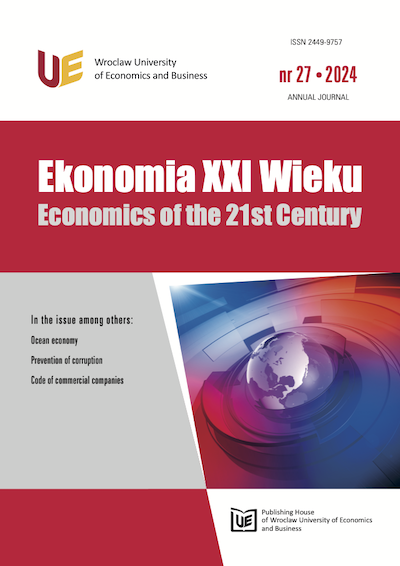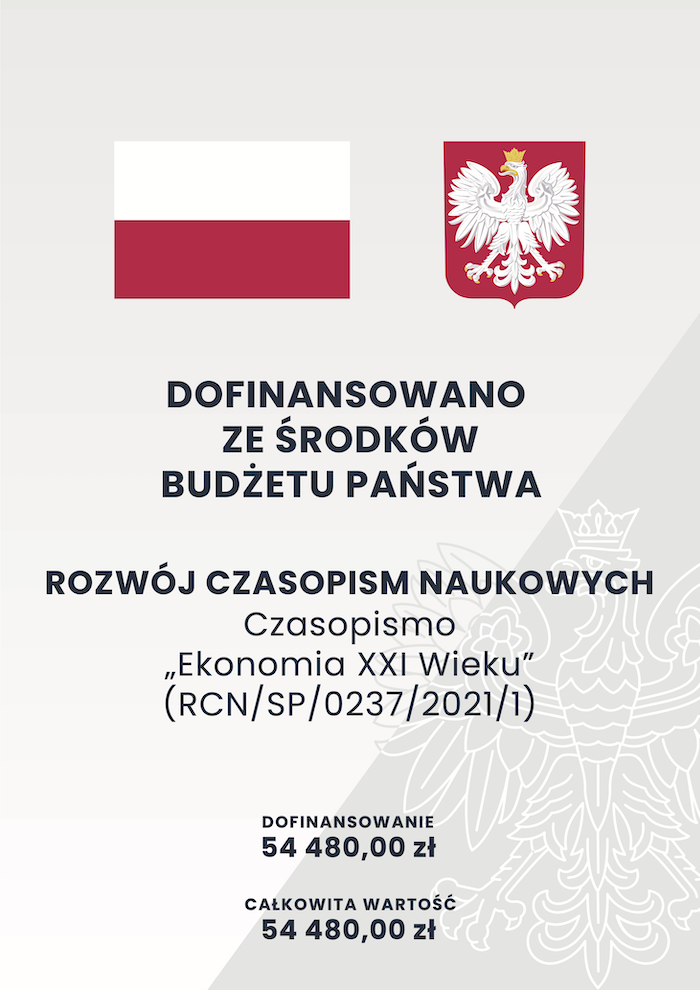Effectiveness of Institutional Monetary Instruments at the Disposal of the Polish Central Bank (NBP). Experiences of the NBP’s Two Years of Struggle Against Inflation
DOI:
https://doi.org/10.15611/e21.2024.06Keywords:
inflation, New Institutional Economics, monetary instruments, Narodowy Bank PolskiAbstract
Aim: The aim of the article is to attempt to answer three research questions: Was it inevitable that inflation would reach such a high (peak and cumulative) level in Poland? Can the fall in the level of inflation in Poland to the level of the European Union average be considered a real and sustainable success of NBP actions? In the struggle with inflation, did the NBP use all the institutional monetary instruments at its disposal?
Methodology: The following methodological assumptions were adopted in the process of presentation, analysis and assessment of institutional monetary instruments. Firstly, as a methodological research requirement, I adopted the recommendation (method of analysis) of Kenneth J. Arrow, according to which analysis of the flow of money provides more information than any other analysis. Secondly, I assessed only the effectiveness of monetary policy instruments in accordance with the methodological assumption, according to which the veracity of statements (the applied monetary instruments) only makes sense in the context of the adopted assumptions (the causes of inflation), whose a priori falsehood determines the falsehood of theories or models (the effectiveness of combatting inflation).
Results: The article conducts an analytical and synthetic assessment of the effectiveness of institutional monetary instruments used by the NBP.
Implications and recommendations: The analysis provides the basis for presenting recommended changes to the strategy for combatting inflation in the future.
Originality/Value: Author’s critical analysis of the effectiveness of the NBP’s use of monetary instruments in the fight against inflation.
Downloads
References
Analizy.pl (n.d.). Struktura oszczędności gospodarstw domowych. Analizy.pl. https://www.analizy.pl/raporty/31631/struktura-oszczednosci-gospodarstw-domowych-wrzesien-2022#:~:text=Struktura%20oszcz%C4%99dno%C5%9Bci%20 gospodarstw%20domowych%20%28wrzesie%C5%84%202022%29%20W%20trzecim,o%20ponad%2050%20mld%20 z%C5%82%2C%20czyli%20ok.%203%25
Bankier.pl (2023a). Handlowy rozbił bank. Zyski ponad dwa razy większe. Retrieved 2023, May 11, from https://www.bankier. pl/wiadomosc/Zysk-netto-Banku-Handlowego-w-I-kw-23-wyniosl-603-8-mln-zl-powyzej-konsensusu-8537959.html
Bankier.pl (2023b) Tyle Polska wydaje poza budżetem. https://www.bankier.pl/wiadomosc/Polska-poza-budzetem-wydaje-wiecej-niz-Niemcy-8506205.html
Ciekaweliczby.pl (2023, April 13). Jak zmieniał się poziom inwestycji w Polsce? https://ciekaweliczby.pl/inwestycje _2022/#:~:text=Inwestycje%20w%20Polsce%20jako%20procent%20PKB%20%28nak%C5%82ady%20brutto,Polsce%20 by%C5%82%20na%20zbli%C5%BConym%20poziomie%20co%20%C5%9Brednia%20europejska
Federal Reserve System (2023, March 3). Monetary Policy Report. Federal Reserve System. https://www.federalreserve.gov/monetarypolicy/files/20230303_mprfullreport.pdf
Getzen, T. E. (2000). Ekonomika zdrowia. Teoria i praktyka. Wydawnictwo Naukowe PWN.
Grabia, T. (2022). Reakcje Narodowego Banku Polskiego na zmiany stóp inflacji i wzrostu gospodarczego w czasie pandemii COVID-19. Folia Oeconomica, 3(360), 18-37. https://doi.org/10.18778/0208-6018.360.02
Kolany, K. (2023, April 19). Europa Środkowa pozostaje inflacyjnym epicentrum. Bankier.pl. https://www.bankier.pl/wiadomosc/Inflacja-w-Unii-Europejskiej-marzec-2023-8525546.html
Kolany, K. (2024, April 17). Polska w inflacyjnym peletonie. Rumunia nowym liderem. Bankier.pl. https://www.bankier.pl/wiadomosc/Inflacja-w-Unii-Europejskiej-w-marcu-2024-Polska-w-srodku-stawki-8730212.html
Konstytucja Rzeczypospolitej Polskiej z dnia 2 kwietnia 1997 r. – (Dz.U. 1997 nr 78 poz. 483)
Lynxbroker.pl (n.d.). Stopy procentowe banków centralnych. Lynxbroker.pl. https://www.lynxbroker.pl/inwestowanie/gielda/informacje-gieldowe/stopy-procentowe-bankow-centralnych/
Misiński, W. (2021. Instytucjonalna Teoria Przedsiębiorstw(a). Paradygmat (?) czy Wstęp (?) do Instytucjonalnej (?)Teorii (?) Przedsiębiorstw(a) (?). Wydawnictwo Uniwersytetu Ekonomicznego we Wrocławiu.
Narodowy Bank Polski (n.d.). Raporty o inflacji. Narodowy Bank Polski. https://nbp.pl/polityka-pieniezna/dokumenty-rpp/raporty-o-inflacji/
Regulation (EU) No 575/2013 of the European Parliament and of the Council of 26 June 2013 on prudential requirements for credit institutions and investment firms and amending Regulation (EU) No 648/2012 Text with EEA relevance
Sedláček, T., & Orrell, D. (2012). Zmierzch Homo Economicus. Studio Emka.
Szczęśniak, P. (2013). Status prawny Narodowego Banku Polskiego w świetle przepisów Konstytucji Rzeczypospolitej Polskiej oraz w orzecznictwie Trybunału Konstytucyjnego. Wybrane zagadnienia. Studenckie Zeszyty Naukowe, 16(23), 117-131. https://journals.umcs.pl/szn/article/view/1404
Taleb, N. N. (2014). Czarny Łabędź. O skutkach nieprzewidywalnych zdarzeń. Kurhaus.
Taylor, J. B. (1993). Discretion Versus Policy Rules in Practice. Carnegie-Rochester Series on Public Policy, 39, 195-214. https://doi.org/10.1016/0167-2231(93)90009-L
Taylor, J. B. (1999). The Robustness and Efficiency of Monetary Policy Rules as Guidelines for Interest Rate Setting by the European Central Bank. Journal of Monetary Economics, 43(3), 655-679. https://doi.org/10.1016/S0304-3932(99)00008-2
Taylor, J. B. (2000). Alternative Views of the Monetary Transmission Mechanism: What Difference Do They Make for Monetary Policy. Oxford Review of Economic Policy, 16(4), 60-73. https://doi.org/10.1093/oxrep/16.4.60
Taylor, J. B. (2007). Explanatory Power of Monetary Policy Rules. Business Economics, 42(4), 8-15. https://doi. org/10.2145/20070401
Trading Economics. (n.d. a) Stopa procentowa – lista krajów. Trading Economics. https://pl.tradingeconomics.com/country-list/interest-rate
Trading Economics. (n.d. b). Bazowy wskaźnik cen konsumpcyjnych - lista krajów. Trading Economics. https://pl.tradingeconomics.com/country-list/core-consumer-prices
Ustawa z dnia 29 sierpnia 1997 r. o Narodowym Banku Polskim (Dz.U. 1997 nr 140, poz. 938).
Ustawa z dnia 29 sierpnia 1997 r. Prawo bankowe (Dz.U. 1997 nr 140, poz. 939). Ustawa z dnia 21 lipca 2006 r. o nadzorze nad rynkiem finansowym (Dz.U. 2006 nr. 157 poz. 1119, Tekst jednolity Dz.U. 2023 r. poz. 753).






